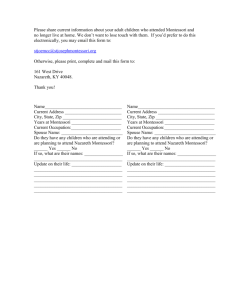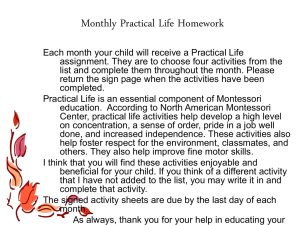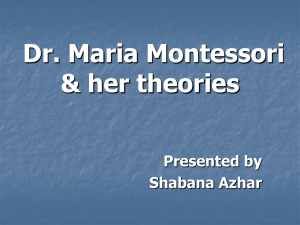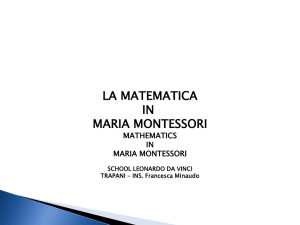AMI-transcript-s-stephenson-7-21
advertisement
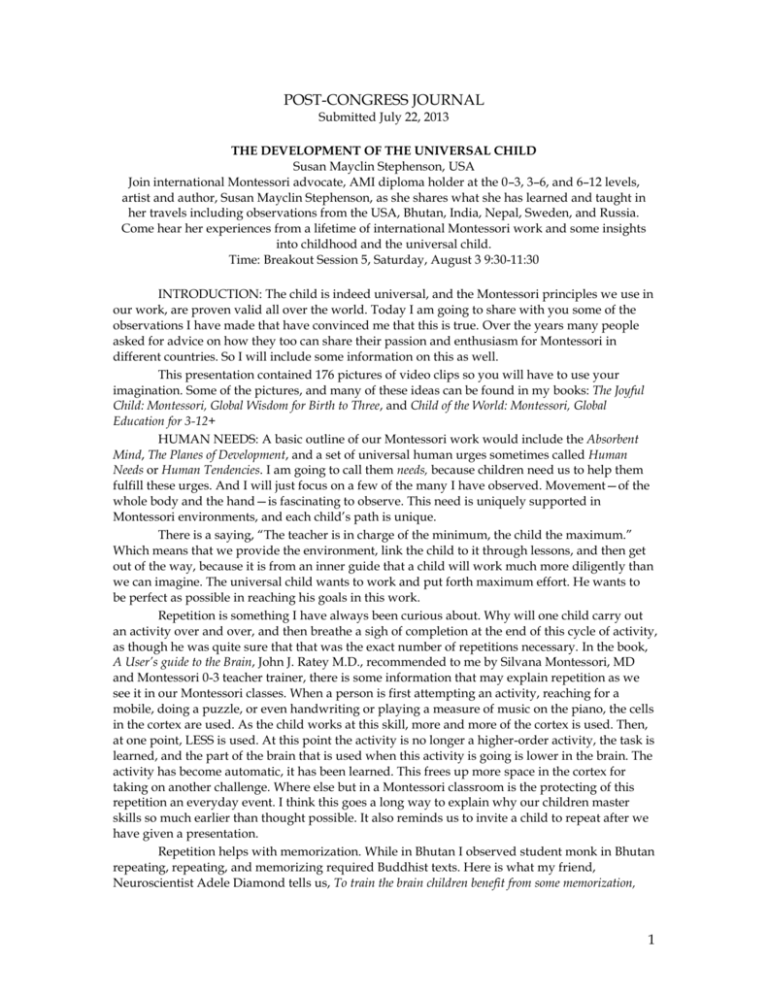
POST-CONGRESS JOURNAL Submitted July 22, 2013 THE DEVELOPMENT OF THE UNIVERSAL CHILD Susan Mayclin Stephenson, USA Join international Montessori advocate, AMI diploma holder at the 0–3, 3–6, and 6–12 levels, artist and author, Susan Mayclin Stephenson, as she shares what she has learned and taught in her travels including observations from the USA, Bhutan, India, Nepal, Sweden, and Russia. Come hear her experiences from a lifetime of international Montessori work and some insights into childhood and the universal child. Time: Breakout Session 5, Saturday, August 3 9:30-11:30 INTRODUCTION: The child is indeed universal, and the Montessori principles we use in our work, are proven valid all over the world. Today I am going to share with you some of the observations I have made that have convinced me that this is true. Over the years many people asked for advice on how they too can share their passion and enthusiasm for Montessori in different countries. So I will include some information on this as well. This presentation contained 176 pictures of video clips so you will have to use your imagination. Some of the pictures, and many of these ideas can be found in my books: The Joyful Child: Montessori, Global Wisdom for Birth to Three, and Child of the World: Montessori, Global Education for 3-12+ HUMAN NEEDS: A basic outline of our Montessori work would include the Absorbent Mind, The Planes of Development, and a set of universal human urges sometimes called Human Needs or Human Tendencies. I am going to call them needs, because children need us to help them fulfill these urges. And I will just focus on a few of the many I have observed. Movement—of the whole body and the hand—is fascinating to observe. This need is uniquely supported in Montessori environments, and each child’s path is unique. There is a saying, “The teacher is in charge of the minimum, the child the maximum.” Which means that we provide the environment, link the child to it through lessons, and then get out of the way, because it is from an inner guide that a child will work much more diligently than we can imagine. The universal child wants to work and put forth maximum effort. He wants to be perfect as possible in reaching his goals in this work. Repetition is something I have always been curious about. Why will one child carry out an activity over and over, and then breathe a sigh of completion at the end of this cycle of activity, as though he was quite sure that that was the exact number of repetitions necessary. In the book, A User’s guide to the Brain, John J. Ratey M.D., recommended to me by Silvana Montessori, MD and Montessori 0-3 teacher trainer, there is some information that may explain repetition as we see it in our Montessori classes. When a person is first attempting an activity, reaching for a mobile, doing a puzzle, or even handwriting or playing a measure of music on the piano, the cells in the cortex are used. As the child works at this skill, more and more of the cortex is used. Then, at one point, LESS is used. At this point the activity is no longer a higher-order activity, the task is learned, and the part of the brain that is used when this activity is going is lower in the brain. The activity has become automatic, it has been learned. This frees up more space in the cortex for taking on another challenge. Where else but in a Montessori classroom is the protecting of this repetition an everyday event. I think this goes a long way to explain why our children master skills so much earlier than thought possible. It also reminds us to invite a child to repeat after we have given a presentation. Repetition helps with memorization. While in Bhutan I observed student monk in Bhutan repeating, repeating, and memorizing required Buddhist texts. Here is what my friend, Neuroscientist Adele Diamond tells us, To train the brain children benefit from some memorization, 1 such as poetry, even though in this information age memorization is not generally though of as valuable. So repetition, learning, memorizing are all human needs and tendencies, of the universal child, and an important part of their development for us to observe and protect. Just as with the universal child’s need for repetition, we are only just beginning to understand the mental and physical benefits of concentration, of training the brain to focus, or to mediate. For an adult to learn to concentrate or meditate it takes effort but as Dr. Montessori told us long ago, it is a natural function of the human personality when it is observed and protected from birth. When the children had completed an absorbing bit of work, they appeared rested and deeply pleased. It almost seemed as if a road had opened up within their souls that led to all their latent powers, revealing the better part of themselves. They exhibited a great affability to everyone, put themselves out to help others, and seemed full of good will. — Maria Montessori, MD The universal child has, as we have seen, the need to move and to develop through movement. He has the need to concentrate on purposeful activities. It is through the fulfillment of these needs that he develops self-control. It is in learning to do such seemingly mundane activities as walking, dressing, dusting, sweeping, preparing and serving food, and fixing or building—work that a child sees going on around him all day long—that he learns to use his body and mind for a purpose, to plan, to concentrate, to control his actions, to finish what he started. These abilities are the Executive Functions (EFs) that Adele Diamond is researching, and that are considered more important than IQ in predicting success in university and in life. More importantly, with this work, the child is able to see himself contributing to the important work of the family, the social group. HOW CAN WE SHARE MONTESSORI WITH THE WORLD? Many people today know that there is something special about this system of education called “Montessori” but it is very important that children be educated by people from their own country. However, until that is possible, there are ways to share. First one must find out what the word Montessori means in this area. In some places it just means that the children are not disciplines by means of corporal punishment. And one must find out what kind of Montessori might already exist. Next it is very important to find out all one can about a country where one is interested in working. Every country in the world, just like every child, has its unique personality, strengths and weaknesses, gifts and needs. And just as a teacher begins by getting to know the child, one must begin by getting to know the country. Coming from the West, I have found that many people have a very strange idea of our culture from what they see on television. And it not a positive impression for the most part. So how might it look for us to come in and present ourselves as having something to offer? We must be aware of this. While on the staff the first AMI Montessori training course in Thailand I discovered that in Thailand meditation is how the children have begun their day for many years. When I was giving a talk on the value of uninterrupted concentration in Thailand I kept hearing the translator use the word samadhi, which means meditation. So the concept of respected concentration of the child was very easy to explain in this culture. We have discussed several human needs, exploration, movement, work, concentration, etc., have saved this one for last, because it very important to understand, in helping children, and in sharing Montessori with the world. This is the human need of communication. Listening is as important as talking. In communication between children, and ourselves and in communicating about Montessori, we often focus on the superior knowledge of the adult or person sharing Montessori. But the child and the student have as much to teach us, as we have to teach them. And we must practice humility to establish true communication. In discussing communication I would like to share a little about mirror neurons. We all know the saying “Children do what we do, not what we say.” Well now we are finding scientific 2 proof of this. The existence of mirror Neurons, discovered by Giacomo Rizzolatti in Pisa, Italy is helping us understand communication in a new way. We have all heard the saying, “Children do as we do, not as we say.” We understand the vital importance of practicing a presentation for the classroom with other adults, paying attention to every detail, before giving a lesson to a child. Mirror neurons were discovered accidently. Electrodes had been placed in the premotor cortex of the macaque monkey to study neurons connected to hand and mouth actions. When the monkey reached for a piece of food the response in the brain could be measured. The scientists discovered that the same neuron was fired even when the monkey watched a human pick up the piece of food! Mirror neurons are activated not only when the individual performs an activity, but also they are activated when we SEE another person perform that activity! This helps us understand not only the learning of physical movements, but emotions, feelings, empathy, imitation, social behavior. I find this very exciting work and it definitely relates to our Montessori work. Neuroscientist V.S. Ramachandran can be seen on a TED video explaining its significance. When one is very experienced as a teacher and knowledgeable about the culture and the adaptions that will be needed, mentoring is an excellent way to share and explain Montessori. Communication with children occurs in many ways beyond talking. Sharing Montessori must be the same. Mentoring this new teacher in Bhutan was an example. It occurred by means of listening, learning about the culture, talking, working, moving, and laughing. WE ARE GUIDED BY NATURE: Thank goodness our work is not an artificial creation by humans imposed upon an unwilling student population. We are, above all, guided by nature. I was asked to share some insights about what I have taught and learned about the universal child. I would like to summarize this by saying that most of us think of Montessori in the context of schools. But Montessori is far, far more than this. As Dr. Montessori said, Whoever touches the life of the child touches the most sensitive point of a whole, which has roots in the most distant past and climbs toward the infinite future. I believe that the human being is born with all of the wisdom and instincts to create a better world: these include the ability to create a physical, mental, and emotional balance for oneself, a compassion for other humans, and a love for the natural world and the earth and the desire to protect it, and the discovery of true happiness. So as we return to our families, and our teaching, even though our work may at present be unappreciated, let us rest in the knowledge that we are protecting the hope for the future. Let us follow the child. 3
